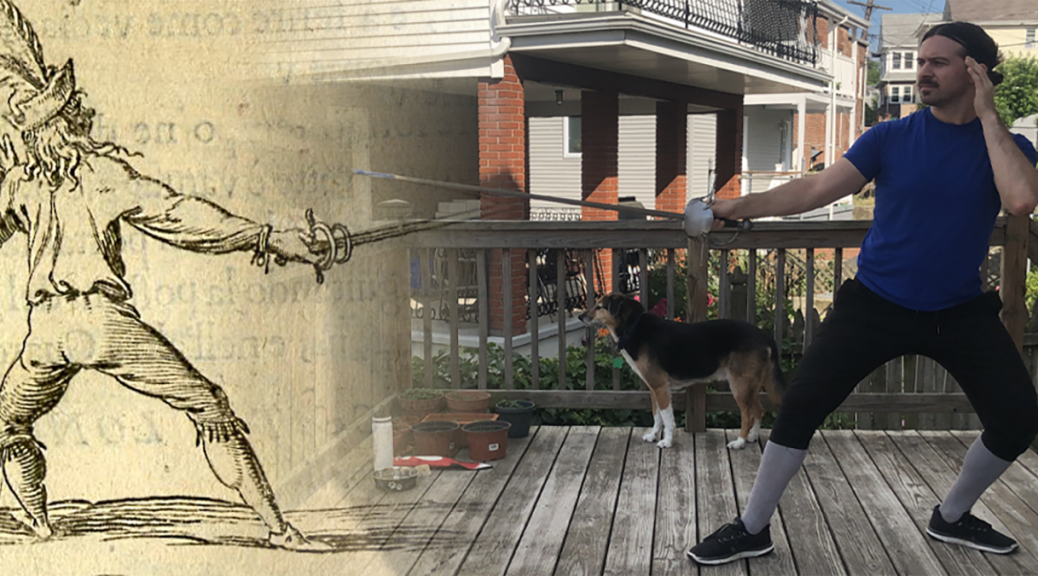“Guards” month for continues for Back to Basics of Italian Rapier class. We’re spending the entire month looking at each of the four primary guards of Italian rapier.
Last night we focused on the third guard — Terza — including how to hold the sword & body in terza, the properties of the guard, it’s uses, and some basic plays folks can do as a solo drill.
The Basics
Terza is the guard most of us naturally get into when we stand in “on guard” with our knuckles facing the ground. It’s also the only one of the primary four guards in which holding the body completely withdrawn back is depicted (though we can do a forward guard version, too).
While most Italian masters show just one version of terza, Fabris shows us three versions — a “natural” version (which is what we mainly see in masters like Giganti & Capoferro), a “proper” version (with the arm straight), and a “low” version where the body is completely withdrawn and the tip is held low. We went over all three of these in class.
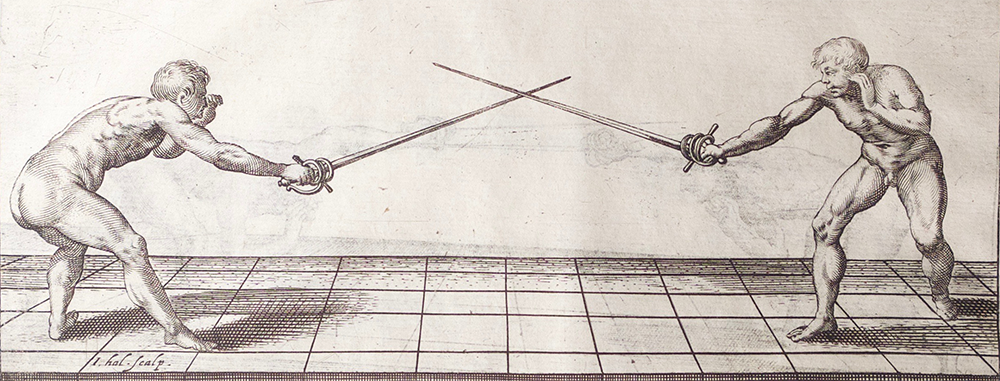
Fabris “natural” terza. Courtesy of Guy Windsor 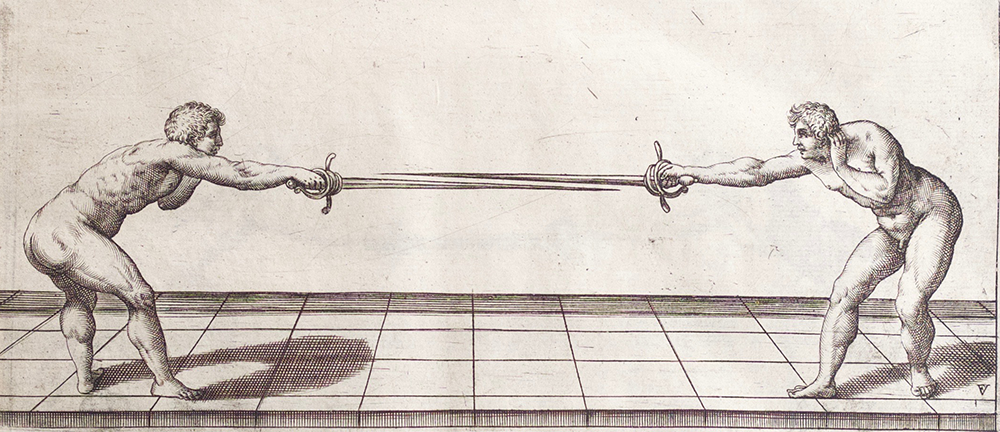
Fabris “proper” terza. Courtesy of Guy Windsor 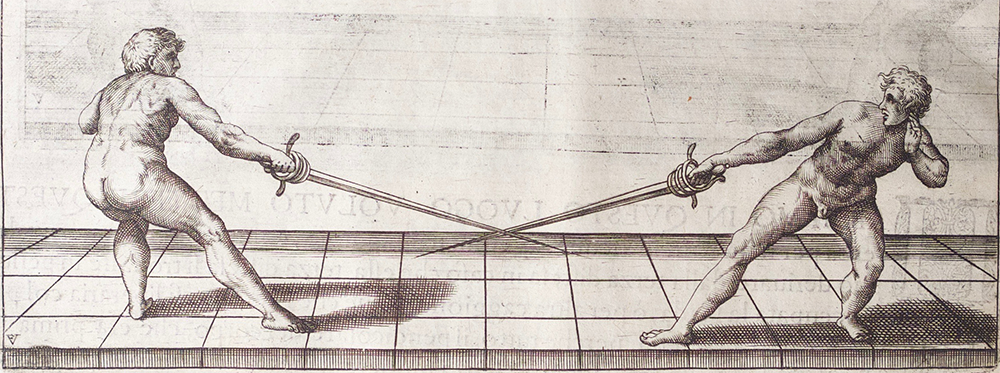
Fabris “low” or “withdrawn” terza. Courtesy of Guy Windsor
And technically, Alfieri has just one terza, however, his guardia mista (“mixed guard”) is basically just a variation of terza and his plays work just fine if you default to terza over guardia mista.
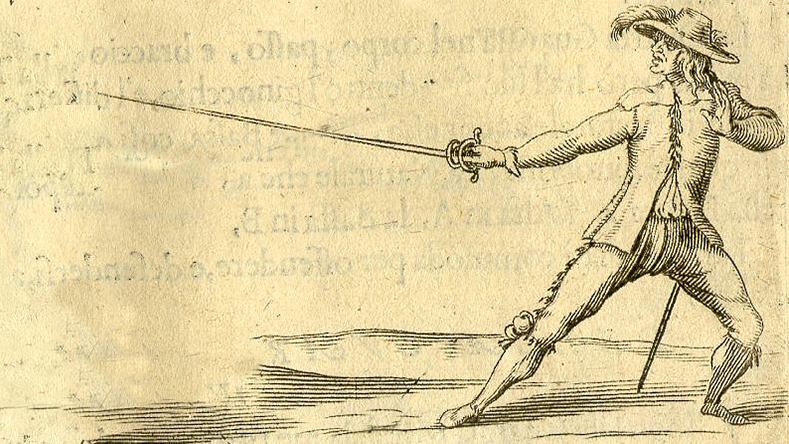
Terza is also the base guard we use for finding our opponent’s weapon, typically turning our hand somewhere between terza and seconda to find on the outside and terza and quarta for the inside.
Properties
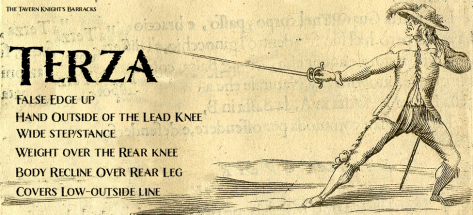
Terza is our base “on guard” hand position. It’s good for defending both the high and low outside lines, depending on blade placement.
The advantages of terza include being a very comfortable and natural hand position. The Italians call this giustezza (literally “rightness” but in this case means “natural”) as the hand is neither angled inside or outside.
It’s a well-balanced posture and can be held in comfortable for a long period time, especially compared to the other three primary guards.
We can find/gain to the inside and outside line, high and low, very easily and quickly from terza. It’s also easier to disorient your enemy, easier to throw feints, and easier to perform cavaziones (though Alfieri thinks quarta is better for that). Offense and defense is both easy.
Terza is also great against angled guards or to counter opponent’s who hold their blade very high, as a way of dominating their point and opening the high line.
Some downsides is that it’s easy to take counterguards against terza, according to Alfieri.
The main advantage of the “natural” terza is that it’s comfortable and easier on your shoulders. The downside is that the point is a little more out of line and the cavaziones are bigger. The main advantage of the “proper” terza (with arm straight) is that the cavaziones are much smaller and therefore quicker. The main disadvantage, however, is it’s more wear & tear on your shoulders. It’s tiring, so make sure you get good back engagement to help take some of the weight.
How to Form Terza
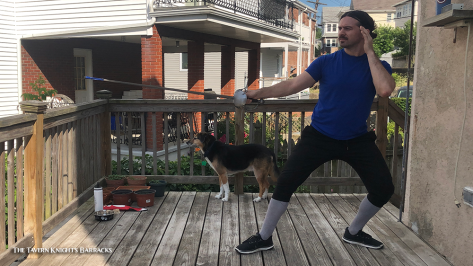
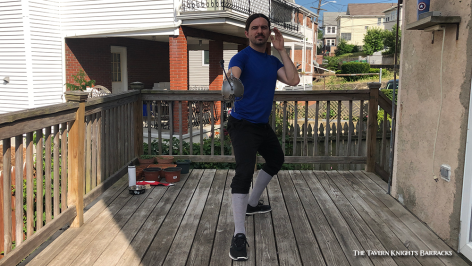
Feet/Stance. Hold your feet in a moderate to wide distance. Roughly 80% of your weight should be held over your back leg.
Arm & Hand. Your arm should be extended a fist or two lengths from your leading flank — or roughly the distance you’d extend your arm to shake a hand. Your hand should be just outside your sword-side knee.
In the forward guard version, you’ll want your arm extended to shoulder height (like in seconda).
Body. In the defensive stance, you want your back shoulder to be in line with your rear hips and knee and with the body as profile as is comfortable while also optimizing your target area.
In the forward guard version, we want to hip-hinge over our forward-facing pelvis.
This hinging doesn’t have to be as extreme as shown in Fabris. A slight or moderate hinge is also fine if that’s more comfortable and you can move just fine.
Also engage your back muscles with a slight retraction of your scapula (shoulder blade). This will help keep your shoulders more neutral which will:
- Shift some of the sword weight off your delts and onto your back, making holding the guard longer a little easier and,
- Lessen the chance of a shoulder injury.
Sword. Your sword should be held with the true edge facing toward the ground and the quillons held vertical.
Head. When in the defensive stance you want your head closer to your off-side shoulder. When in the forward guard, your head should be tucked safely behind your hilt, closer to your leading shoulder but still to your inside line.
Off-Hand. In the defensive stance, your off-hand should be held by your face or held by your sword-elbow (a closed off-hand position).
When striking in terza, you can throw the arm back (like in Capoferro) or chicken-wing it (like in Fabris), or you can use one of two closed-guard variations.
The first version is with the sword high. You’ll want to keep your off-hand and arm under your sword-arm to cover the low-outside line. It should look like a closed-seconda.
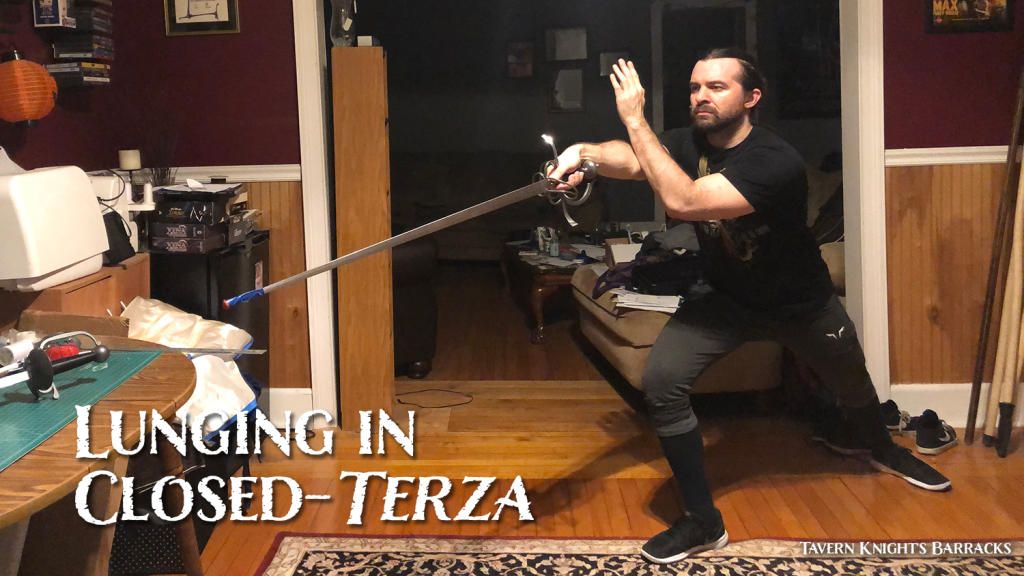
The other version is with the sword-tip low (shown above). The sword arm should still be at shoulder height but you should relax your grip a smidge so the point of your sword naturally dips below your opponent’s guard. Your off-hand and arm should be over your sword to protect your head. Make sure you tuck your elbow in to get maximum height in the closed-terza.
Plays
Play #1 – Feinting (Plate 22, Fabris)
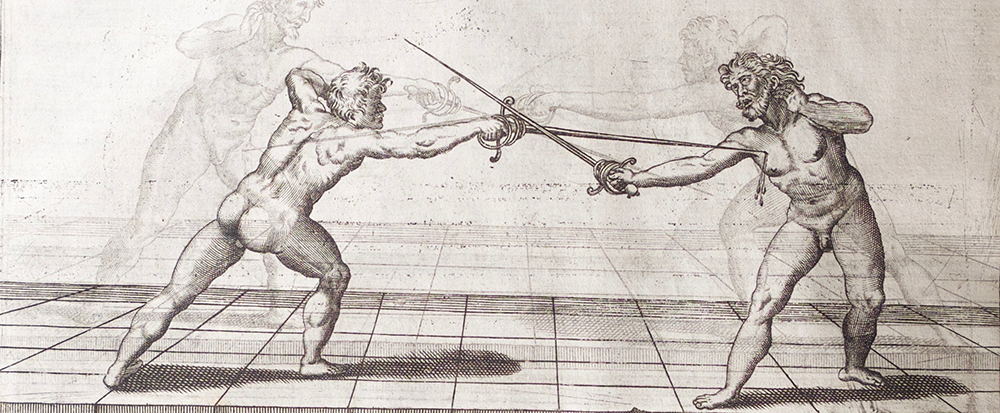
Terza is a great guard for feinting and then making a quick cavazione to the open line. This play does both of those things plus striking in terza.
- Perform a straight-line feint to the inside line
- Your opponent moves to parry the feint
- We perform a cavazione in the tempo of the feint to the outside line and thrust in a straight line over our opponent’s sword
Play #2 – Countering a Cut (Plate 28, Fabris)
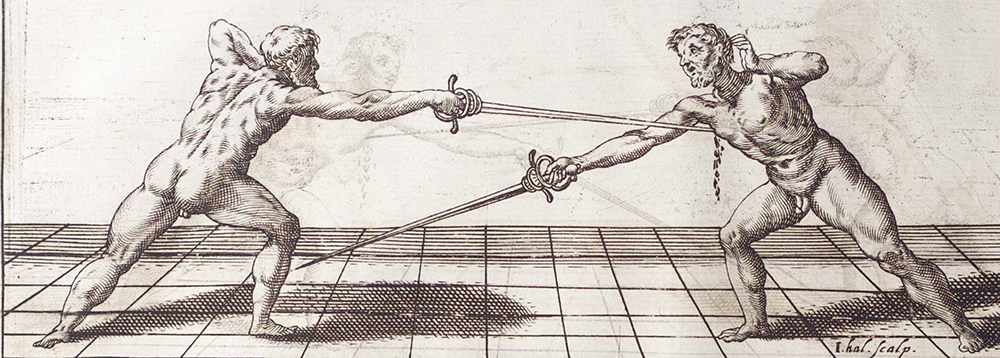
Fabris notes it’s better to avoid a cut when possible than to collect it. This is best done when it happens from a wider measure (misura larga). Here’s one way that can play out.
- From the outside line, move to find your opponent’s blade while transitioning into a forward guard
- Your opponent throws a mandritto at your head.
- Withdrawn your body into the defensive posture of terza while lowering the tip (like shown in The Basics section).
- The opponent’s blade will safely pass by your body, only cutting air.
- Once their point is safely passed you, strike in terza
The goal here is to strike while the opponent’s blade is still out of your presence. Fabris shows the attack with the arm fully-extended at shoulder height and with the tip dipping to strike the chest. However, an alternate hand position is still in terza but with the guard a little low and the tip driving upward into the opponent’s chest. This would get your guard in the way of your opponent trying to get their sword back online.
Play #3 – The Scannaturra (Capoferro)
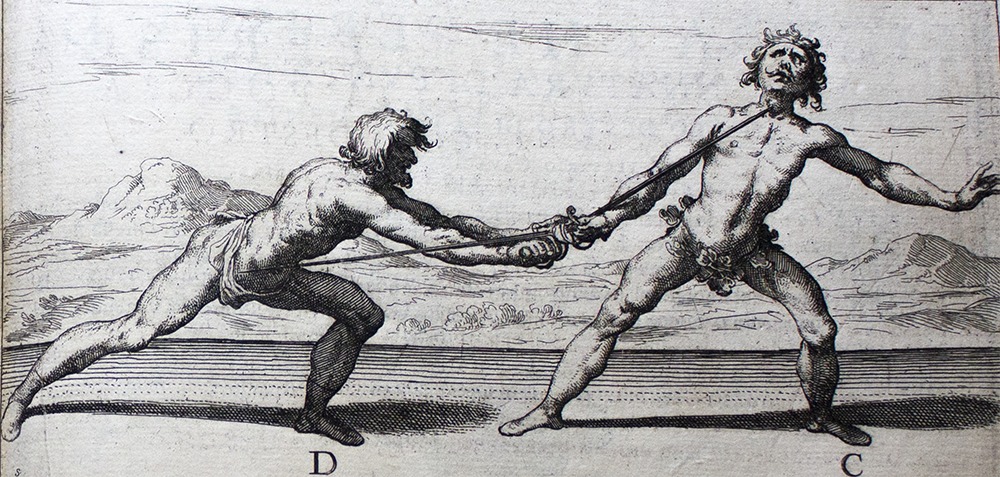
The scannaturra is a type of transport found in Capoferro. It can be done with a lunge, though traditionally with a pass. The hand can be held in seconda or in terza as the situation calls for.
- Find your opponent’s sword on the inside line
- Your opponent performs a cavazione to attack on the outside line
- In tempo, perform a contracavazione to keep them on the inside line. Immediately drop your point over their sword and down, transporting their blade to your low outside line.
- Strike with a pass or a lunge. Use your off-hand to grasp the opponent’s hilt or as support for your sword.
Play #4 – Off-Hand Parry (Plate 43, Fabris)
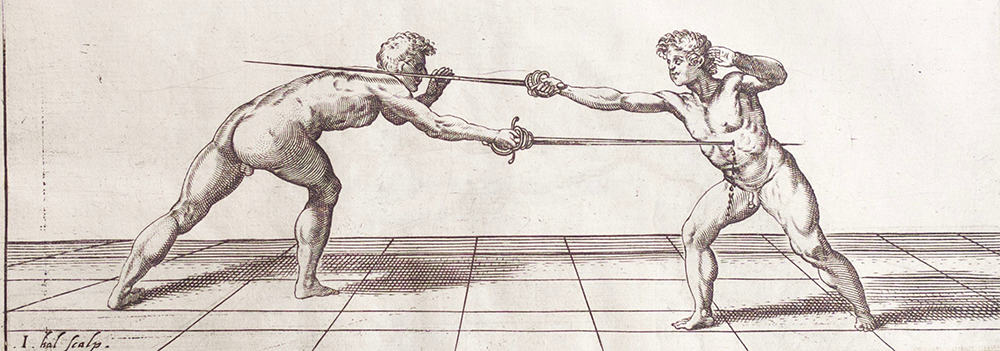
In single rapier, the off-hand is primary used as backup and support. However, it can be used to parry the opponent’s weapon. In a fight with sharps, this would be done judicially, but in our sport-version of rapier fighting, using the off-hand can be pretty advantageous.
- From the outside line, press against your opponent’s blade
- Your opponent performs a cavazione to strike you on the inside line in quarta
- Parry with your off-hand, by bringing it across your body, taking the opponent’s sword to your outside line. At the same time, drop your point below your opponent’s hilt and strike in terza.
Also note that it appears Fabris is performing this counterattack while performing a cross-line lunge to his inside. It’s worth exploring doing this play with a straight lunge vs. the cross-line lunge.
Play #5 – Countering the Leg Shot
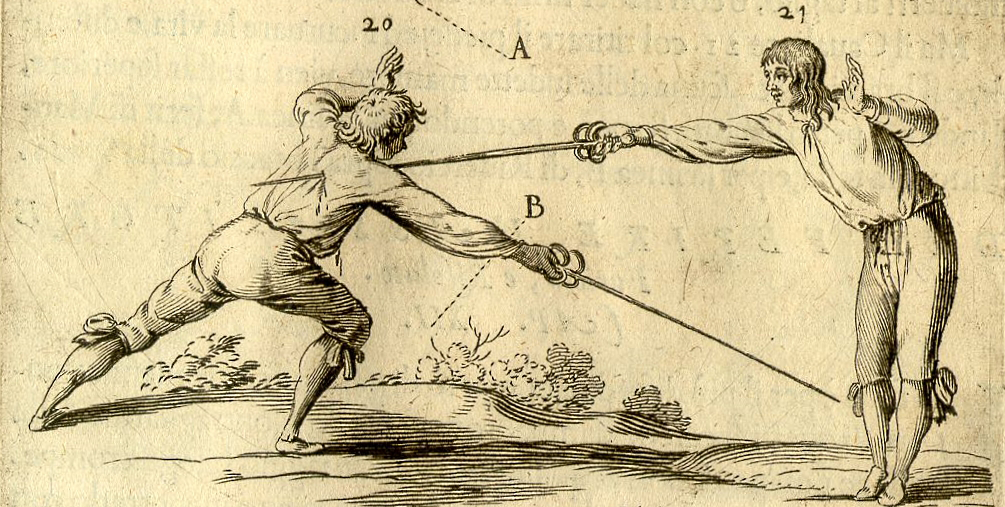
Attacking the leg is fraught as you lose a ton of reach going for the leg or foot. However, it still happens as it’s typically an open target. We can use terza to counter this attack.
- Find your opponent on the inside line
- They perform a cavazione and throw an attack to your leg
- You can either:
- Slip the leg by performing a half reverse-pass
- OR withdraw your lead leg so your heels almost touch
- At the same time as you remove your leg target from your opponent’s reach, extend your arm in terza striking the opponent’s face, chest, or sword-arm.
Class Video
Here’s a recording of the class. It’s more or less what’s written out in this blog post, plus a strength/conditioning routine in the second half of the class.
DONATIONS: Classes are 100% free, however, if you find these sessions useful, please consider a small donation so I can continue to produce rapier & other historical martial arts content. Donate at https://www.paypal.me/thetavernknight

